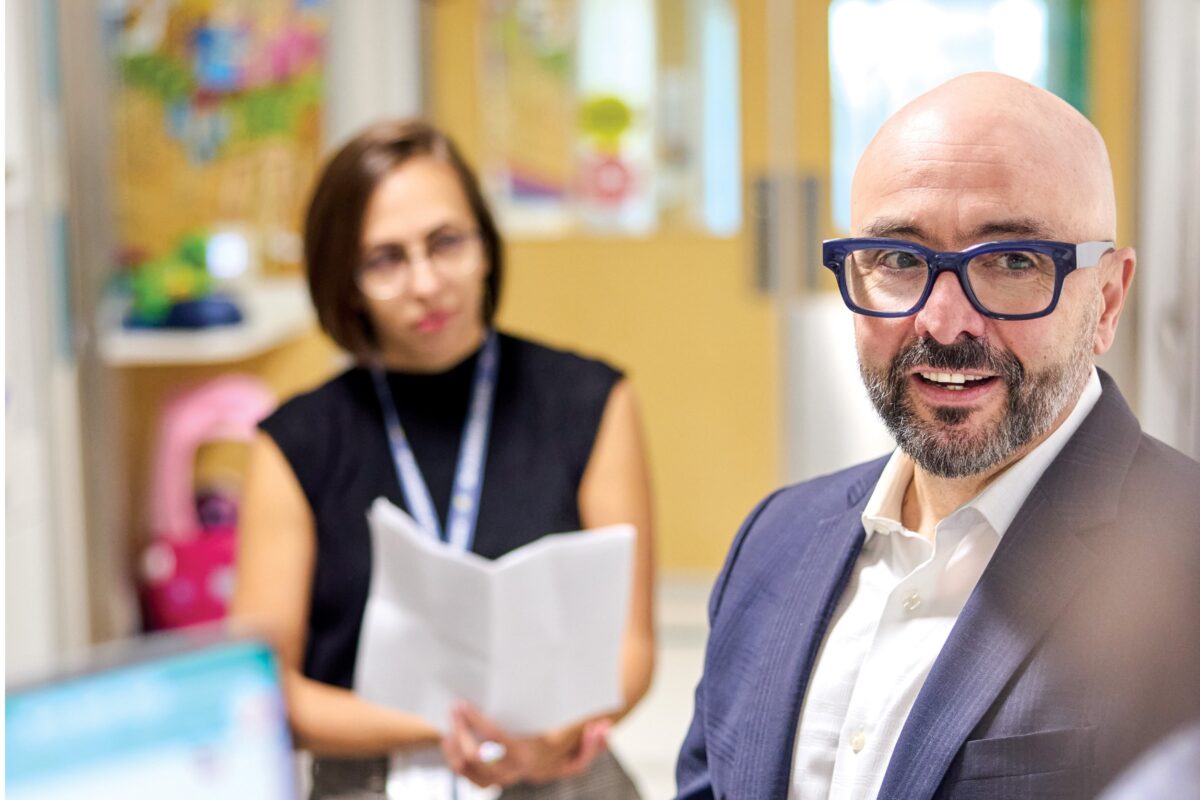
In children and teenagers, all cancers are rare — underscoring why it’s critical to seek out physicians who specialize in treating pediatric cancers.
“All pediatric cancers require specialized expertise and individual treatment approaches,” explained Jorge Di Paola, MD, who leads WashU Medicine’s pediatric hematology and oncology division and treats patients at St. Louis Children’s Hospital through the Siteman Kids pediatric cancer program. “We are uniquely positioned to treat all types of pediatric tumors and are a major referral center for leading-edge pediatric cancer care.”
WashU Medicine pediatric cancer specialists offer the full breadth of treatment options for children and teens with cancer — from standard therapies and advanced treatments to clinical trials. Patients and their families also benefit from the vast number of pediatric subspecialists available through Siteman Kids, including WashU Medicine hematologists and oncologists, neurologists and neurosurgeons, orthopedists, diagnostic imaging specialists and pathologists.
As a top pediatric cancer center in the U.S., Siteman Kids treats about 750 patients each year, including about 150 who are newly diagnosed.
“We also have access to a growing roster of innovative clinical trials,” said Di Paola, an internationally recognized expert on pediatric blood disorders, and the Elizabeth Finney McDonnell Chair in Pediatric Hematology & Oncology. “And we provide some of the most innovative targeted therapies for cancer treatment, including proton beam therapy and immunotherapies that have produced lifesaving outcomes.”
Siteman Kids offers more than 100 pediatric clinical studies evaluating the effectiveness of investigational chemotherapy drugs or new drug combinations; genomic testing and personalized vaccines for patients with recurrent brain tumors; short-course radiation therapy with the aim of reducing treatment time for patients; and ongoing novel immunotherapies for blood cancers such as acute myeloblastic leukemia.
One of Siteman Kids’ strongest assets is the extensive collaboration among WashU Medicine pediatric physicians, researchers, nurses and research coordinators — it’s what attracted Di Paola to WashU Medicine in 2019. “The overall collaboration here,” he explained, “is unparalleled. We work so well together because of our common goal to fight with and for our young patients and do everything possible to ensure the very best outcomes.”
Looking ahead, this shared goal will continue to drive the innovation that keeps Siteman Kids at the forefront of pediatric cancer care and research, with WashU Medicine physicians striving to set new standards of excellence.
A chance to live life to the fullest
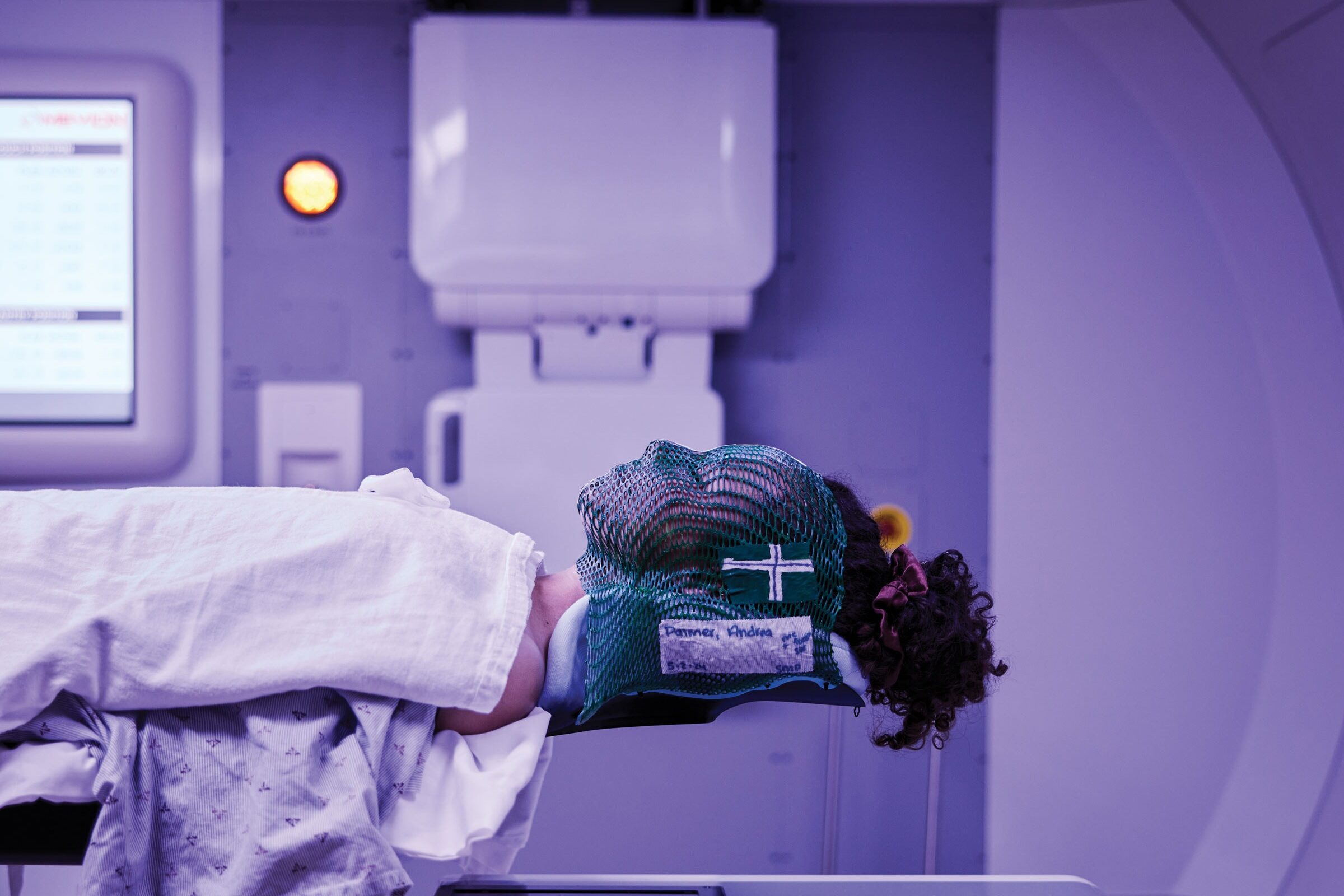
Last spring, severe pressure in the back of Andrea “Drea” Palmer’s head made it hard for the 15-year-old to play soccer, read or create the glittery art she loves. Sometimes she struggled to see straight.
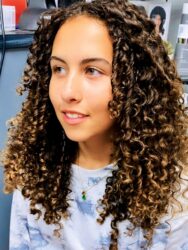
MRI scans in April at St. Louis Children’s Hospital revealed a medulloblastoma, a fast-growing, malignant brain tumor near the base of her skull. Drea and her family were in the right place. Top WashU Medicine pediatric cancer specialists have extensive experience treating patients with pediatric brain tumors through the Siteman Kids program.
About 600 children in the U.S. receive a medulloblastoma diagnosis each year. Treatment typically involves surgery followed by radiation therapy. At Siteman Kids, children receive the most advanced radiation therapy: pencil-beam proton therapy delivered to the brain with a narrow beam that “paints” the radiation dose onto the tumor.
“With proton therapy, we have greater ability to control the dose and limit radiation exposure to nearby tissues,” said Stephanie M. Perkins, MD, director of the S. Lee Kling Proton Therapy Center at Siteman; the S. Lee Kling Endowed Chair in Radiation Oncology; and chief of the pediatric radiotherapy service at WashU Medicine and St. Louis Children’s Hospital. “This is especially important for young patients such as Drea. We want to achieve a cure for these children while limiting any side effects of treatment. We want to give them the best chance to live like they did before cancer.”
About 85% of children with medulloblastoma survive, and Drea’s prognosis is very good, Perkins said. “With such a good prognosis, it’s important to examine the long-term side effects of having and being treated for a brain tumor,” she said.
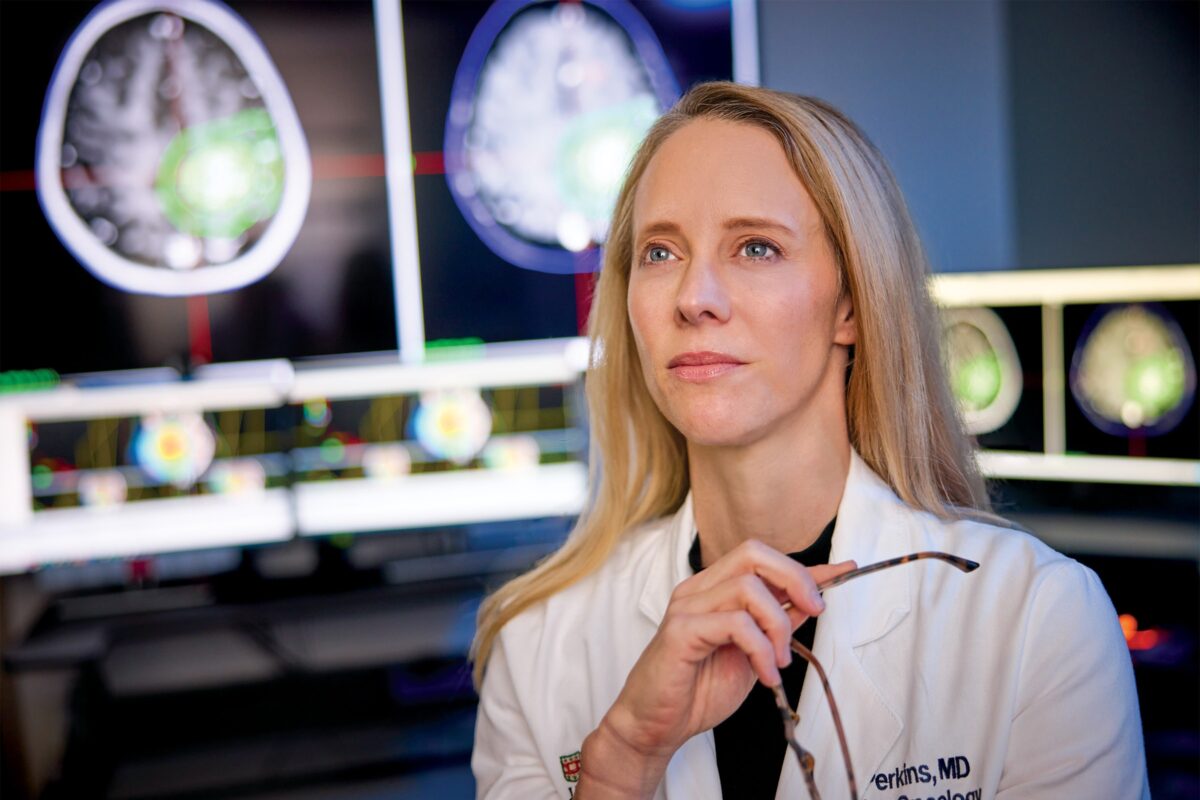
Before surgery to remove the tumor, Drea underwent additional brain imaging for a WashU Medicine study led by Perkins aimed at identifying biomarkers to determine whether a child is at risk for treatment-related cognitive issues.
Her research aims to detect changes in cognitive function by using resting-state functional MRI, a noninvasive technique pioneered by WashU Medicine physician-scientists including neuroscientist Marcus Raichle, MD, the Alan A. and Edith L. Wolff Distinguished Professor of Medicine and a professor of radiology at WashU Medicine’s Mallinckrodt Institute of Radiology. Resting state refers to brain activity that occurs when a person is unengaged — for example, daydreaming or sleeping. By determining which parts of the brain are in communication, researchers can define functional networks, including those impacting memory, attention and learning.
Early results have shown that some pediatric tumor patients experience changes in brain organization that can affect cognition, said Perkins, who collaborates with researchers in radiology and neuroscience. “Using imaging to identify important biomarkers could allow us to understand the basis of cognitive changes and may aid in identifying children who would benefit from additional resources to navigate challenges at school or elsewhere,” she said. “We want Drea and all of our patients to pick up where they left off and live their lives to the fullest after treatment,” Perkins said. For now, Drea focuses on life post treatment: “I’m going to sleep in without worrying, play soccer and hang with my friends, like normal.”
“We needed a miracle”
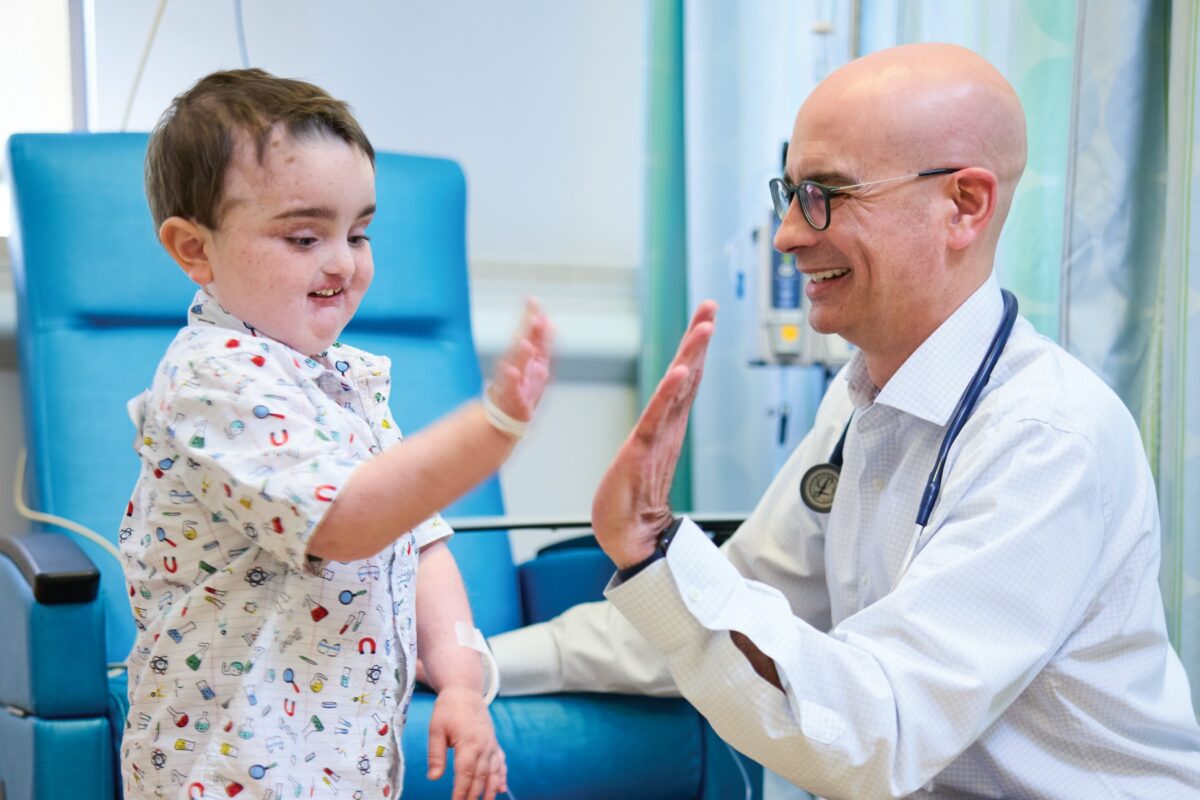
Emily Robinett’s world stopped Jan. 4, 2018 — the moment doctors delivered her baby boy’s diagnosis.
Leukemia, they said.
Specifically, 7-month-old Weston Robinett had acute myeloid leukemia (AML), a cancer of the blood and bone marrow.
Terrified, Robinett went into mom mode. “I read every medical journal I could find and followed every lead, no matter how small,” said the elementary school teacher from Kansas City, Mo.
“I had to do everything I could for Weston.”
Standard therapy for AML entails chemotherapy and a stem cell transplant from a donor, with the aim of long-term remission. But a month after receiving a transplant, Weston’s cancer returned.
Doctors told Robinett what she already had gleaned from her research: More than 90% of patients with relapsed AML die within a few months to a year.
“We needed a miracle,” she said.
Weston’s miracle arrived as a tip via Facebook from a parent who had heard about a phase 1 clinical trial at Siteman Kids at St. Louis Children’s Hospital, co-led by pediatric oncologist Jeffrey J. Bednarski, MD, PhD, an associate professor of pediatrics at WashU Medicine.
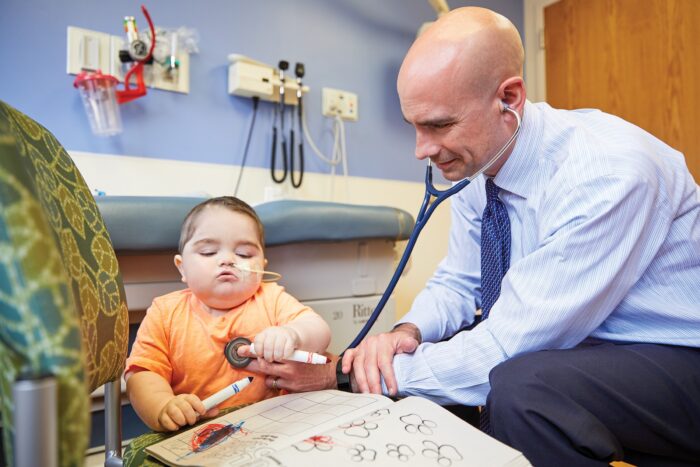
The trial involved an innovative immunotherapy that harnesses “natural killer” cells, a type of immune cell that attacks cancer. The immunotherapy originated in the laboratory of WashU Medicine physician-scientist Todd Fehniger, MD, PhD, co-leader of the Hematopoietic Development and Malignancy Program at Siteman and a professor of medicine in the division of oncology, who had shown that memory-like natural killer (NK) cells were effective in treating adults with recurrent AML. Fehniger collaborated with Bednarski on the pediatric trials and generated the NK cellular therapy that patients receive at Siteman and Siteman Kids.
Within a week, Weston was enrolled in the trial.
Weston’s therapeutic NK cells were collected from his mother. Before administering the cells to Weston as therapy, his mother’s NK cells were exposed to proteins in the lab that supercharged them to attack his leukemia cells more effectively.
“And Weston experienced no major side effects from the treatment,” Bednarski said.
The first phase of the clinical trial enrolled seven other patients. Weston was among six of them to respond positively to the therapy.
Eighteen children and young adults to date have undergone treatment with NK cell immunotherapy at Siteman Kids.
There is always a risk that the cancer can return, so this past May, researchers began screening patients for a new trial that will give donor NK cells to patients as part of initial chemotherapy treatments to prevent relapse. “We want to cure patients up front,” Bednarski said. “We want them to return to the lives they had before cancer.”
Weston is now a 7-year-old, Spiderman-loving, Fortnite-playing first-grader with an aptitude for science. During his monthly checkup trips to St. Louis, he sometimes offers research suggestions.
“He wants Dr. Bednarski to find a way to eliminate the use of shots, because Weston doesn’t like them,” Robinett said, laughing. “Maybe he’ll grow up to be a scientist like Dr. Bednarski, who is like a member of our family. We love the people at Siteman Kids, and we’re so grateful to everyone for saving Weston’s life.”
Added Bednarski: “Weston is an energetic, playful, incredible kid. Our team is so happy that he is thriving. That is our goal for all children with acute myeloid leukemia.”
Explore the extensive scope of cancer care and research.
Published in the Autumn 2024 issue


